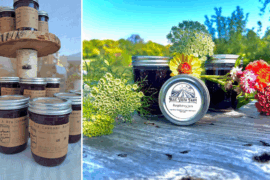By Betty W. Stark
This article originally appeared in the 2011 fall/winter issue of experience WISCONSIN.
A few years ago, California’s dairy farmers taunted Wisconsin with predictions that not only would their (allegedly) happy cows produce more milk, but they would also produce more cheese than the dairy state within a matter of months.
With that warning, the Wisconsin Milk Marketing Board and state dairy farmers rallied and responded in chorus, “no way!”
The race was on, but only briefly. Wisconsin cheese production pulled ahead and has stayed there, a happy conclusion to the brief skirmish. The confrontation focused a golden spotlight on the abundance of award-winning small-batch cheeses crafted at many of the 129 plants throughout the state.
Wandering through Wisconsin’s bucolic green hills and valleys, it’s easy to imagine that the cows love it here. But according to Myron Olson, Certified Master Cheesemaker and manager at the Chalet Cheese Cooperative just outside Monroe, it’s the purity of water, naturally filtered through glacial limestone layers, that contributes to the nuances of Wisconsin’s many cheese types.
Chalet Cheese has the notable distinction of being the only remaining producer of Limburger cheese in the country. They’ve been showcased on the travel Channel, History Channel and CNN, to name a few. The pungent surface-ripened cheese, affectionately known as “stinky cheese,” is about 20 percent of Chalet’s production, the balance represented by their award-winning Brick and Baby Swiss cheeses. Myron hints that topping their Limburger with strawberry or apricot jams elevates it to gourmet status.
At Carr Valley Cheese in south central Wisconsin, fourth generation owner and Master Cheesemaker Sid Cook is probably the most decorated in the entire state, earning hundreds of awards for his innovative and new-style cheeses made the old-fashioned way — by hand.
Cook readily admits he even dreams about cheese, contemplating the vast possibilities of bold flavors and cutting-edge combinations showcasing the qualities of cow, sheep and goat milks that he purchases from nearby farms. His sumptuously smooth Cocoa Cardona goat cheese, rind rubbed with velvety cocoa powder, is a fine example, especially when paired with a port wine.
The Carr Valley website (www.carrvalleycheese.com) is a gold mine of information about their 80-plus cheeses, including suggested beverage pairings, as well as details about the Carr Valley Cooking School in Sauk City, a series of tantalizing offerings led by well-known chefs like Kristine Subido of the popular WAVE restaurant on Chicago’s North Lake Shore Drive.
In Mineral Point’s historic Shake Rag district, Tony and Julie Hook have been producing cheese for 41 years, winning numerous awards, including World Champion Colby honoring Julie Hook, the only woman cheesemaker to take the world prize. Their cheeses are widely distributed nationally and are favored by noted chefs, including Stephanie Izard, high-profile chef/owner at the girl and the goat restaurant in Chicago’s West Loop.
Hook’s Cheese Company’s most recent accomplishment is a limited-production 15-year-old cheddar that is so sought-after it sold for $80 a pound at the Cheese Store of Beverly Hills. California could not help but notice.
This article originally appeared in the 2011 fall/winter issue of experience WISCONSIN. Some of the written details may have changed since the article was published.
No portion of this article or magazine may be reproduced without prior written permission by the publisher.





Comments are closed.